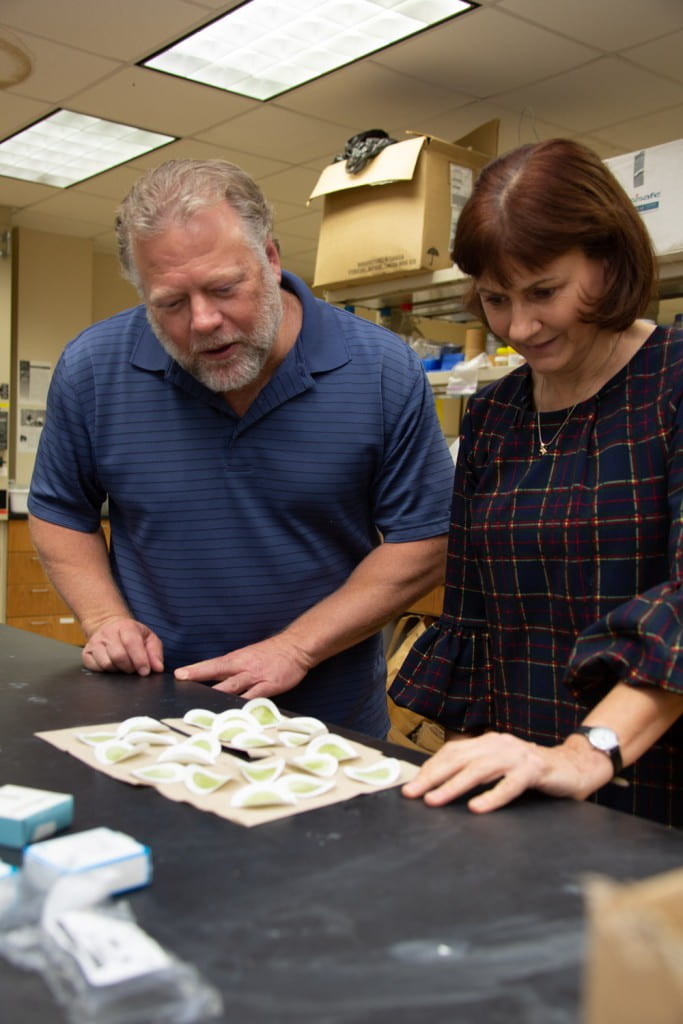Chromium-6 (Cr VI) is an odorless and tasteless metallic element. In industry, it is used as an additive, endowing alloys to improve strength, hardness, temperature resistance and preventing corrosion, for instance.
But it is also a contaminant that is toxic, carcinogenic and mutagenic. It’s safe to say that one would prefer to avoid Chromium-6 in drinking water.

Student and faculty researchers at UW-Green Bay’s Marinette and Green Bay campuses, have teamed up to take a closer look at how cyanobacteria (often called blue-green algae) might be able to biologically filter the toxic element out of water. This could lead to both safer drinking water and could one day inform companies in various industries how to recycle and reuse the element.
What started as a grant proposal for former Marinette Campus student Sarah Klemp (now enrolled in the Chemistry at Green Bay), has become a full-fledged research opportunity for Klemp and fellow UW-Green Bay student researcher Becky Berry (Environmental Science). Working closely with the students are Marinette Campus Associate Professor Mark Klemp (Sarah’s father) and Green Bay Campus Professors Patricia Terry and Michael Zorn.
The project will compare removal of Cr(VI) from water using live and dead algae to determine if the removal is purely surface absorption or if there is a metabolic component.
“Our research is testing cyanobacteria’s bioremediation capacity of hexavalent chromium and the mechanisms responsible,” explained Klemp and Berry. “To do this, we expose both living and dead bacteria to various known concentrations of chromium solutions. After the exposure, we filter out the bacteria and test the new concentrations of the chromium solutions. The difference in concentration shows how much chromium the bacteria removes, if any.”
“By virtue of receiving the grant (officially a UW System Water Research Advisory Council Undergraduate Research Fellowship from the UW System Water Research Collaborative), the students will be presenting their research among their UW colleagues at the Research in the Rotunda event in April of 2019,” said Terry. “In addition, we believe their research paper will has the potential to be published, which bodes well for their college portfolios and future opportunities. Plus, it could have future implications in industry settings.”
Prof. Klemp says the collaboration between the faculty, students and two campuses has gone smoothly.
“This collaboration was not only exciting by having the opportunity to work with faculty from different disciplines, but the ability to work with colleagues from different campuses was a great way to integrate our new institution.”

Assistant Prof. Renee Richer, who was on sabbatical last semester, mentored the students last year.
Klemp and Berry explain where the idea for the research began. “Living in northeastern Wisconsin has revealed many issues of pollution particular to our area. We decided to focus on the two primary concerns: heavy metal pollutants and agricultural runoff. Luckily, our biology professor, Dr. Richer, has an extensive background knowledge of cyanobacteria (blue-green “algae”) and was a major pioneer of the project. With an environmental scientist and chemist on the team, we decided bioremediation (the use of living organisms to consume or break down pollutants) would not only be relevant but serve our community. After attempting the project in Marinette with professors Richer and Klemp, we realized more resources were necessary to continue.”
 Reaching out to UW-Green Bay’s professors Terry and Zorn, helped them see this issue from a different perspective and provided the students with additional opportunities and resources. “Dr. Terry’s previous work with cyanobacteria and heavy metals allowed us to utilize her successful techniques. Prof. Zorn helped us tremendously with the operation of lab equipment that could better analyze our samples.”
Reaching out to UW-Green Bay’s professors Terry and Zorn, helped them see this issue from a different perspective and provided the students with additional opportunities and resources. “Dr. Terry’s previous work with cyanobacteria and heavy metals allowed us to utilize her successful techniques. Prof. Zorn helped us tremendously with the operation of lab equipment that could better analyze our samples.”
The undergraduates are excited about their project which has provided a school-of-hard-knocks from time to time as they saw some setbacks.
“The project is going very well now because of all the advising we receive from the professors involved,” they said. “There were even a couple moments when we thought, ‘This is it! We actually see good results!’ only to find that we did not actually see meaningful data, instead we made a mistake and had to start over. We follow our own procedure, so every failure we encounter is new and difficult to anticipate but so obvious in hindsight. That is the hardest part… trying so hard with so many different techniques and improvements but still without success. The smallest breakthroughs provide enough momentum to keep us motivated.”
Their hypothesis is that living cyanobacteria will remove more chromium from the solution than dead cyanobacteria due to its ability to adsorb and metabolize, as compared to the dead which will only be able to remove through adsorption.
“We believe this is a possibility and run tests that will either support our reject our hypothesis. Either way, we conduct ourselves and the project without bias and accept the results.”
The transition between the Marinette and Green Bay campus comes with both benefits and challenges, they say.
“Green Bay has opened the door to so many more opportunities, resources, and intelligent people willing to aid us in the process. We do work at both campuses since half of the team is from Marinette and the other half is from Green Bay, so the hardest part is traveling between here and the Marinette campus.”
–end–


